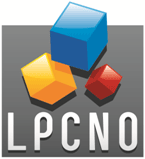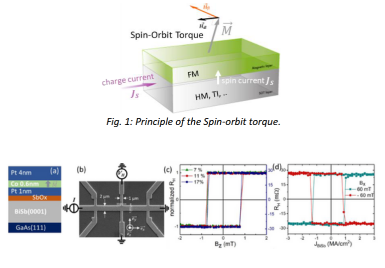2D FERROMAGNET/TOPOLOGICAL INSULATOR HETEROSTRUCTURE FOR SPIN-ORBIT TECHNIQUE
MATERIAL AND SURFACE SCIENCE

Lab: LPCNO
Duration: NanoX master Internship (8 months part-time in-lab immersion)
Latest starting date: 02/01/2025
Localisation: LPCNO Bat.27. 135 avenue de Rangueil.
31077 Toulouse - FRANCE
Supervisors:
Thomas BLON thomas.blon@insa-toulouse.fr
Work package:
Current-induced magnetic torques known as spin-orbit torques (SOTs) allow for the electrical
manipulation of the magnetization 𝑀 in thin-film heterostructures and consequently have application
in low-power magnetic memories and logic devices. Due to their high spin-orbit interaction generating
spin Hall effect (bulk) and/or Rashba-Edelstein effect (interfacial), heavy metals (HM) such Pt and Ta,
are reference material as SOT source, i.e. they convert a charge current density 𝐽𝐶 into a spin current
density 𝐽𝑆 which is absorbed by an interfaced ferromagnet (FM) and generates a torque on its
magnetization (Fig. 1). However, they present low efficiency, with critical 𝐽𝐶 injected in the HM for
magnetization switching as high as 106-108 A/cm2. For reducing 𝐽𝐶 and power, promising SOT materials
are topological insulators (TIs), such as BiSbTe and BiSb: these
materials possess strong spin-orbit coupling and consequent
conductive surface states with spin-momentum locking that
enables a high spin accumulation and critical current densities
one order of magnitude lower than for heavy metals. However,
the reported charge-to-spin conversion efficiency varies
drastically depending on the TI deposition method, crystalline
and interface quality of the TI/FM heterostructures.
The Nanomagnetism group at LPCNO studies TI/FM heterostructures, namely BiSb/Pt/Co/Pt, with
BiSb as the TI (grown by MBE at LAAS, Toulouse), and cobalt as the ferromagnet (Fig.2(a)). We already
demonstrated the SOT-driven magnetization reversal in this system with 𝐽𝐶 ≈ 106 A/cm2 (Fig.2(d)). The
proposed internship will focus on the optimization of the spin transparency at TI/FM interface to
enhance torque efficiency and therefore reducing critical current. We will focus on the additional
buffer layer at the BiSb (and BiSbTe)/Co interface to promote the Co perpendicular anisotropy and spin
transparency. Alternatively, we will use van der Waals FM, exfoliated and directly transferred on TI, in
order to benefit from the weak interaction between layers of this kind of materials to avoid intermixing
at TI/FM interface. The internship concerns (i) the deposition and characterization of such TI/FM
heterostructures, (ii) the electrical measurement of the magnetic properties thanks to anomalous Hall
effect (AHE) in Hall bars designed samples (Fig.2(b)-(c)), and (iii) the SOT measurements (Fig. 2(d))

References:
/
Areas of expertise:
Master 2 or engineering degree, specializing in physics of matter, nano-physics and nanotechnology.
Required skills for the internship:
The student should have a definite attraction for experimentation and multidisciplinary.
A PhD position will be available after the internship, depending on financing
